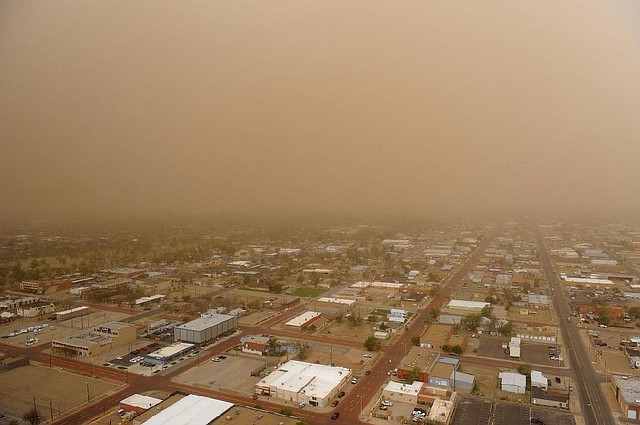Southwest's drought rivals Dust Bowl
Dust storms rake Southern Plains despite much-improved farming practices
High winds create a dust storm across the Texas panhandle, shrouding Amarillo in a cloud of red dirt on April 29. Droughts in several states have made some areas drier than they were during the Dust Bowl period in the 1930s.
Sunday, May 11, 2014
LUBBOCK, Texas -- The sky turns pink or brown as the dust clouds billow and swirl on the Southern Plains, leaving those caught outdoors with grit on their teeth and in their eyes, much like the days of the Dust Bowl.
Due to the drought conditions that have been a constant presence since 2011, some parts of the Texas and Oklahoma panhandles, northeastern New Mexico and southeastern Colorado are drier now than they were during the infamous dry spell of the 1930s.
Experts have said the possibility of another Dust Bowl is unlikely because of modern irrigation and farming techniques aimed at holding soil in place. But greater erosion in recent years has resulted in an increasing number of dust storms, including one last month that lasted three days in Lubbock.
The dust storms are an indirect result of the drought, according to Tom Gill, a geology professor at the University of Texas-El Paso who has studied the phenomenon for years.
"The drought leads to reduced land cover ... making it far more difficult to keep the soil anchored to the ground," he said. "To get a real strong dust storm you need a combination of barren land and strong winds," Gill said.
In the 1930s, farmers plowed up 100 million acres, and billions of tons of topsoil blew away, filling the skies across five states with soil. Scientists with the federal government's Soil Conservation Service -- now the Natural Resources Conservation Service -- stepped in after the man-made ecological disaster and tried to stem erosion.
Progress was slow initially, but since the 1980s, more U.S. farmers have moved to soil conservation practices, minimizing the disturbance of the soil's surface and making it less likely to take flight in high winds. The results are telling: In 1982, more than 3 billion tons of soil nationwide were lost to wind and water erosion. That dropped to 1.72 billion tons in 2010, according to data from the conservation service.
David Ford lives in a part of the Texas panhandle that's drier now than in the 1930s. He has used a strip-till process to conserve soil for about 10 years.
"If it hadn't been for a lot of these changes, it would really be bad," said Ford, who grows corn, cotton, wheat and grain sorghum on more than 4,000 acres about 50 miles north of Amarillo.
The number of dust storms seems to rise with the length of the drought.
Amarillo, Texas, has had 10 this year. It had none in 2010. The city is about 10 percent drier now than the 42 months that ended April 30, 1936, and drier than the state's record drought in the 1950s.
Lubbock already has seen 15 days with dust storms this year, the National Weather Service said. In 2011, a rare 1.5-mile-high, 250-mile-long dust cloud stretched across the rain-starved land and blotted out the sun. There were only four in 2010, which was the last wet year across Texas.
Weather service officials in southeastern Colorado only began issuing dust storm warning this year because they were becoming more prevalent. So far, the Pueblo office has issued 15 warnings. Two hours east, Lamar had only 32.6 inches of rain during the 42 months that ended May 31, 2013 -- about 10 percent drier than the same time period in ending May 31, 1934.
Parts of Kansas, which isn't yet as dry as in the 1930s, saw a two-day dust storm last month. Some blew in from eastern Colorado, which is drier than Kansas, but a lot is coming from the state's plowed fields.
Multiyear droughts like the region has endured make dust storms more likely and frequent, said weather service meteorologist Justin Weaver in Lubbock, though that city can see dust storms in wetter years because of cold fronts or large thunderstorms.
"The drier it is the more opportunities there are for dust to get lofted in the air," he said. "We're not in very good shape."
A Section on 05/11/2014
